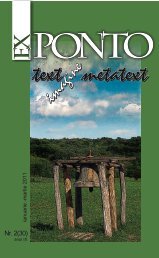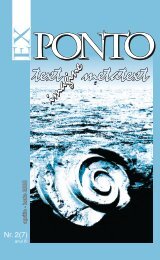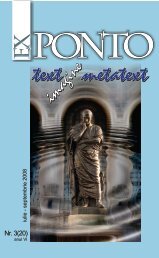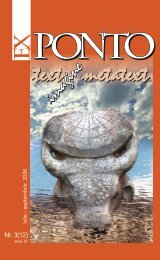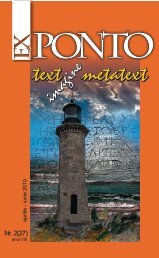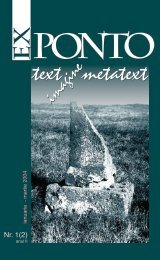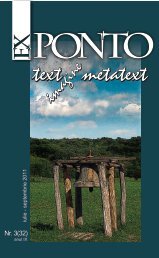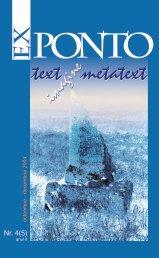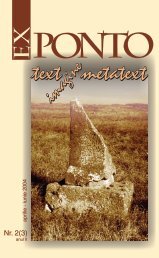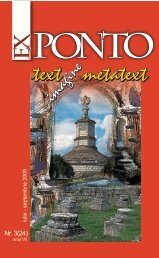Nr. 4 (21) anul VI / octombrie-decembrie 2008 - ROMDIDAC
Nr. 4 (21) anul VI / octombrie-decembrie 2008 - ROMDIDAC
Nr. 4 (21) anul VI / octombrie-decembrie 2008 - ROMDIDAC
Create successful ePaper yourself
Turn your PDF publications into a flip-book with our unique Google optimized e-Paper software.
EX PONTO NR.4, <strong>2008</strong><br />
116<br />
become well known to American readers even before the 1926 exhibition<br />
and the scandal stirred up the American public and excited the press. From<br />
1913 to 1929, the American press dedicated an important number of articles<br />
to Brâncu[i’s art. The first series published between 1913 and 1924 focused<br />
primarily on his modernist aesthetics; the second series from 1926 to 1929<br />
and after tried to justify his excessive modernist ideas through his embedded<br />
Romanian identity.<br />
Bird in Space, 1923<br />
New York Times was one of the broadly read<br />
newspapers which reviewed his exhibitions wherever they<br />
were organized, New York or Paris. Although its readers<br />
might have found the continuous reference to Brâncu[i’s<br />
origin redundant, both the anonymous chroniclers and the<br />
critics who signed their articles repeated at some point in<br />
their texts that the modernist sculptor was Romanian. The<br />
October 3, 1926 issue published the article New York’s<br />
Statues Called Ridiculous in which the columnist quoted<br />
Brâncu[i’s opinions about American architecture and<br />
sculptures in public places. While he praised the New York<br />
architecture as “poetic,” “modern,” and “beautiful,” he called<br />
its sculptures “ridiculous” and in complete disharmony with<br />
their context. It would not take long before his own pieces<br />
would be declared “Kitchen utensils,” in their turn. The man<br />
who dared to criticize American public art is presented as:<br />
“Brâncu[i is short, has iron-gray hair and wears a bushy<br />
beard. He was born Rumanian, but has been working at<br />
his art for the last twenty-five years in Paris.” It seems that the author of the<br />
text tried to excuse his rudeness by referring to his “barbaric” origin. For this<br />
category of reviewers, the Romanian sculptor together with the French artists<br />
in his group were the others, not only in specific terms of aesthetics, but also<br />
in the more general terms of morals and culture. 9<br />
One month later, L.K. came back to the same topic of New York architecture<br />
and skyline, as seen through the eyes of the Romanian sculptor: “I couldn’t<br />
have done better.” At the end of November 1928, a short note about the<br />
Romanian artist appeared in New York Times under the title Brâncu[i Work<br />
Duty Free. The reiteration of his origin maintained the indirect references<br />
to Romanian identity in the public eye as long as Brâncu[i’s works were<br />
contested, admired, commented on, or simply mentioned. 10<br />
Conclusion<br />
In the long run, Romanian identity in the United States has been borne<br />
by Romanian folk costumes and the art of Brâncu[i. The fact that famous<br />
American museum such as the MOMA and the Philadelphia Museum of Art<br />
have in their permanent collections valuable pieces by Brâncu[i maintains<br />
Romanian identity culturally alive for those interested in arts. Continuing the<br />
dream of American collectors, John Quinn and Louise and Walter Arensberg,<br />
these museums preserve and exhibit the most precious aspect of Romanian




